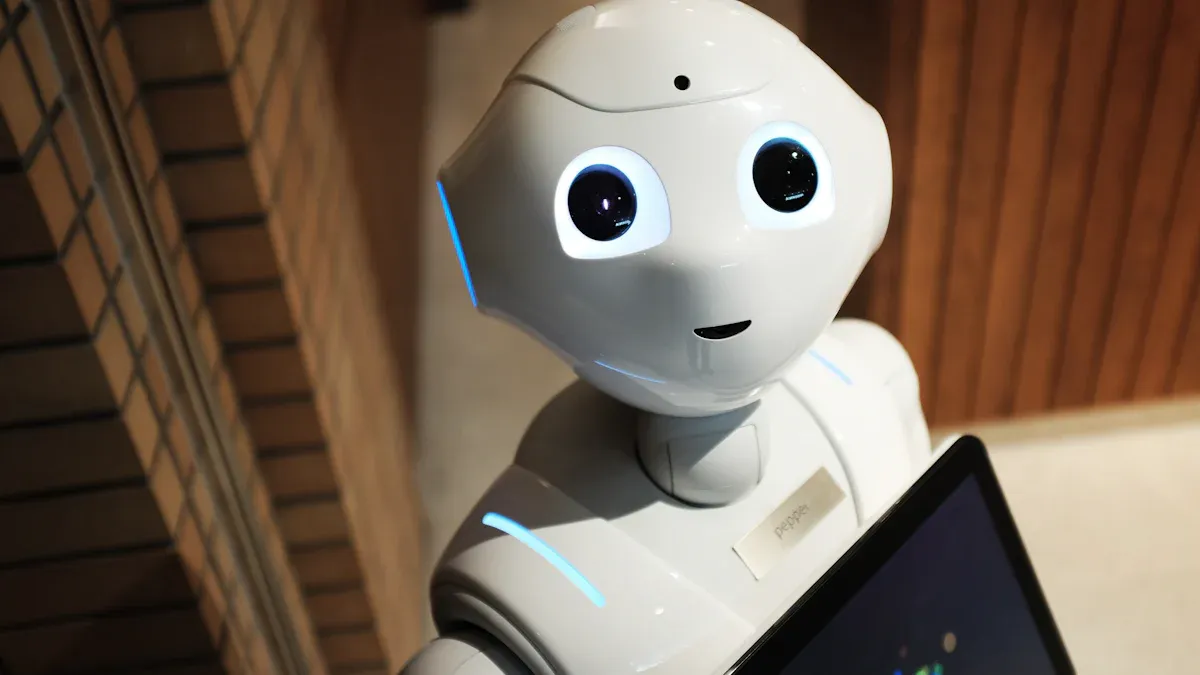AI's Role in Shaping Talent Ecosystem Networks

Artificial intelligence is transforming how you engage with talent ecosystem networks. It accelerates recruitment processes, making them faster and more efficient. AI tools personalize candidate experiences by offering real-time updates and tailored job recommendations. They also reduce biases in hiring, ensuring fairer selection processes. Predictive analytics match candidates to roles more effectively, increasing the chances of successful hires. Beyond hiring, AI-driven insights help you understand employee needs, improving retention by addressing turnover factors. This AI era is redefining workforce strategies, creating a dynamic environment for both organizations and individuals.
Key Takeaways
AI speeds up hiring by sorting resumes, making it quicker and easier.
It gives job seekers custom suggestions and updates to keep them interested.
AI helps remove unfairness in hiring, supporting equal chances and diversity.
It predicts skill shortages and future needs, helping plan ahead for jobs.
Using AI wisely can improve work strategies, boost output, and make jobs more flexible.
Redefining Talent Ecosystem Networks with AI

Understanding Talent Ecosystems
Talent ecosystem networks are dynamic systems that connect people, processes, and technology to meet organizational goals. These ecosystems thrive when they align with business needs and adapt to changing demands. You can enhance their effectiveness by focusing on several key components:
Flexibility in processes and employee experiences.
Collaboration across HR functions to streamline operations.
A clear talent strategy that supports investment in workforce transformation.
Partnerships with HRIS and IT to prevent future bottlenecks.
A focus on the desired performance culture to maintain competitive positioning.
Regular assessments of your talent ecosystem ensure it evolves with advancements in artificial intelligence and shifts in customer expectations. Annual reviews by cross-functional teams help update skill matrices and adjust processes to meet future demands.
AI's Impact on Talent Ecosystem Dynamics
Automating Routine HR Tasks
AI technologies simplify repetitive HR tasks, freeing up time for strategic initiatives. For example, generative AI can automate resume screening, reducing the time spent on talent acquisition. It also streamlines onboarding by automating document verification and training schedules. This automation improves efficiency and allows HR teams to focus on enhancing the employee experience.
Enhancing Collaboration with AI Platforms
AI-powered platforms foster collaboration across departments. These tools centralize data, making it easier for you to access real-time insights and share them with stakeholders. Generative AI can also assist in creating personalized communication strategies, ensuring alignment between HR and other business units. This integration strengthens your talent ecosystem networks and supports seamless recruiting and retention efforts.
Real-Time Workforce Insights
Artificial intelligence provides real-time insights into workforce trends, helping you make informed decisions. Predictive analytics identify skill gaps and forecast workforce needs, enabling proactive planning. For instance, AI can analyze employee engagement data to predict turnover risks and suggest targeted interventions. These insights drive talent transformation by aligning workforce strategies with organizational goals.
AI Applications in Workforce Strategies
Revolutionizing Talent Acquisition
AI-Powered Recruitment Tools
AI-powered recruitment tools are transforming how you approach talent acquisition. These tools automate processes like resume screening, interview scheduling, and candidate matching. By leveraging generative AI, you can identify top candidates faster and reduce the time-to-hire. The efficiency of AI-driven recruitment becomes evident when compared to traditional methods:
Aspect | AI-Driven Recruitment | Traditional Recruitment |
|---|---|---|
Time-to-Hire | Faster due to automated processes like screening | Slower because of manual reviews |
Cost per Hire | On average, 20% lower thanks to automation | Higher due to labor-intensive processes |
Scalability | Handles large volumes efficiently | Limited by human capacity and working hours |
These tools not only save time but also improve the quality of hires, ensuring your talent ecosystem networks remain competitive.
Reducing Bias in Hiring
AI reduces unconscious bias in hiring by focusing on data-driven decisions. Generative AI creates unbiased job descriptions and evaluates resumes based on objective criteria. Research shows that AI tools help eliminate human biases, fostering a fairer recruiting process.
Evidence Description | Source Reference |
|---|---|
AI automates recruitment and selection, helping to eliminate unconscious human biases. | Raub, M. (2018). Bots, bias and big data: artificial intelligence, algorithmic bias and disparate impact liability in hiring practices. Ark Law Rev 71:529. |
AI tools create accurate job descriptions and screen resumes more effectively. | Miasato, A., & Silva, F.R. (2019). Artificial intelligence as an instrument of discrimination in workforce recruitment. Acta Univ Sapientiae: Legal Stud 8(2):191–212. |
By integrating AI into your talent acquisition strategies, you can build a more inclusive workforce while enhancing efficiency.
Upskilling and Reskilling with AI
Personalized Learning Experiences
AI technologies enable personalized learning experiences tailored to individual needs. Generative AI and machine learning analyze employee performance data to recommend targeted learning and development programs. This approach ensures employees acquire the skills needed for their roles, supporting both upskilling and reskilling efforts.
Predictive Skill Gap Analysis
Predictive analytics revolutionize workforce development by identifying skill gaps and forecasting future needs. This proactive approach allows you to align your workforce with organizational goals. Key benefits include:
Optimized resource allocation for increased productivity.
Improved talent management by nurturing high-potential employees.
AI tools provide accurate insights into skill gaps, enabling you to make informed decisions and drive talent transformation.
Driving Workforce Agility
Dynamic Workforce Planning
AI adoption supports dynamic workforce planning by analyzing real-time data. Generative AI helps you adapt to changing demands, ensuring your workforce remains agile. This flexibility is crucial for navigating the rapid transformation of industries.
Supporting Remote and Hybrid Work Models
AI technologies play a pivotal role in supporting remote and hybrid work models. Tools like AI chatbots enhance collaboration, while machine learning predicts potential challenges, enabling proactive solutions.
Aspect | Description |
|---|---|
Improved Collaboration | AI chatbots and assistants enhance communication among team members, regardless of location. |
Automation of Routine Tasks | AI automates mundane tasks like scheduling, allowing employees to focus on strategic work. |
Increased Productivity | AI tools provide insights for better workload management, improving time management and productivity. |
Training & Development | AI offers personalized learning recommendations based on employee performance data. |
By leveraging AI, you can create a flexible and productive work environment that meets the needs of the future workforce.
Overcoming Challenges in AI Adoption
Ethical Considerations in AI Use
Addressing Algorithmic Bias
AI systems can unintentionally perpetuate biases, leading to unfair outcomes in hiring and workforce management. For example, biased algorithms may favor certain demographics, creating discriminatory practices. You must prioritize fairness by regularly auditing AI tools to identify and mitigate biases. High-quality datasets are essential for ensuring accuracy and equity in AI applications. Additionally, aligning AI systems with human values helps maintain dignity and fairness in talent transformation processes.
Ensuring Transparency and Accountability
Transparency builds trust in AI technologies. You can achieve this by clearly communicating AI's role and providing explanations for its decisions. Establishing a governance council ensures human oversight and compliance with ethical guidelines. An ethics charter can outline commitments to fairness, accountability, and privacy. Regular audits and risk management practices further enhance transparency, helping you address potential challenges in AI adoption effectively.
Integrating AI into Workforce Strategies
Managing Resistance to Change
Resistance to AI adoption often stems from fear of job displacement or a preference for traditional methods. To overcome this, you should communicate the benefits of AI, such as improved work-life balance and time savings. Involving employees in decision-making fosters ownership and trust. Open forums and Q&A sessions allow you to address concerns empathetically, reducing skepticism and encouraging collaboration.
Building AI Literacy in HR Teams
AI upskilling is crucial for successful workforce transformation. Start by assessing current capabilities and identifying knowledge gaps. Develop a structured learning framework that includes hands-on experiences with AI tools. Encourage collaboration between HR, IT, and data science teams to build cross-functional expertise. Creating AI champions within your organization can drive innovation and foster a culture of continuous learning and development.
Balancing Human and AI Collaboration
Preserving Human-Centric Talent Management
AI technologies should enhance, not replace, human-centric talent management. Focus on ethical AI systems that improve fairness and accuracy in recruiting and onboarding. Human expertise remains vital for fostering empathy and creativity, ensuring that AI complements rather than overshadows human qualities.
Redefining Roles in the AI Era
AI adoption reshapes roles within talent ecosystem networks. You should prioritize upskilling and reskilling to prepare employees for future demands. Emphasize the importance of human intuition and critical thinking, which AI cannot replicate. By balancing AI-driven processes with human strengths, you can create a workforce ready for the challenges of tomorrow.
Future Trends in AI and Workforce Strategies

Predictive Analytics for Talent Management
Anticipating Workforce Needs
Predictive analytics is revolutionizing how you manage talent by providing actionable insights into workforce trends. It identifies potential performance issues and forecasts employee behavior, enabling you to address challenges before they arise. By analyzing historical data, predictive tools help you anticipate future skills needs and talent gaps.
Predictive analytics allows you to:
Maximize overall performance by identifying potential issues early.
Forecast workforce needs to align with organizational goals.
Develop targeted retention strategies to reduce turnover.
This proactive approach ensures your workforce remains agile and prepared for transformation.
Proactive Succession Planning
AI tools streamline succession planning, ensuring leadership continuity. By analyzing employee performance and potential, these tools identify high-potential candidates for critical roles.
Benefit | Statistic |
|---|---|
Reduction in voluntary turnover rates | 49% reduction among identified high-potential employees |
Faster time to fill leadership positions | 23% faster time reported by companies leveraging AI |
According to Deloitte, 70% of organizations prioritize succession planning, highlighting its importance. By 2025, half of large enterprises are expected to adopt AI-enabled succession management tools, reflecting a shift toward data-driven strategies.
Advancing DEIB with AI
Measuring and Enhancing DEIB
AI enhances diversity, equity, inclusion, and belonging (DEIB) by uncovering hidden biases in workplace dynamics. Advanced analytics track diversity metrics in real time, identifying disparities in representation and pay equity. AI-supported hiring platforms anonymize candidate data, reducing subjective judgments and implicit biases.
Key applications include:
Real-time feedback channels to foster transparency and trust.
Personalized learning paths to address cultural competency gaps.
Accessibility technologies like automated captioning to promote inclusivity.
These tools create a culture where every voice is heard, driving innovation and collaboration.
Creating Inclusive Workplaces with AI
AI-powered tools objectively analyze resumes and applications, focusing on skills and qualifications. They remove identifying information, preventing bias based on name, gender, or age. Virtual reality platforms powered by AI offer immersive learning experiences, bridging education gaps and fostering inclusivity.
Adaptive Leadership in the AI Era
Preparing Leaders for AI-Driven Teams
Leaders managing AI-driven teams need empathy, strategic thinking, and the ability to lead change. Empathy helps you connect with team members during transitions, while strategic thinking enables you to foresee challenges and innovate. Focusing on people development ensures your team remains engaged and prepared for transformation.
Essential leadership qualities include:
Empathy to understand team dynamics.
Strategic thinking to navigate AI adoption.
A commitment to upskilling and reskilling employees.
Fostering Continuous Learning and Innovation
To thrive in the AI era, you must foster a culture of continuous learning and experimentation. Encourage employees to explore AI tools and reward creative integrations into workflows. Share success stories to inspire innovation.
“Establishing a culture open to AI adoption starts with encouraging a growth mindset by promoting continuous learning and experimentation.”
By connecting with employees on an emotional level, you can build resilience and a commitment to growth, ensuring your organization remains competitive in the future.
AI is revolutionizing how you approach talent ecosystem networks. It offers opportunities to redefine roles, streamline processes, and enhance productivity. Generative AI enables you to focus on higher-value tasks while fostering continuous learning. By embracing AI adoption responsibly, you can drive transformation and create adaptable workforce strategies. However, addressing ethical challenges and providing resources for adaptation remain critical. This approach ensures your organization thrives in a rapidly evolving landscape, leveraging AI to optimize operations and make data-informed decisions.
FAQ
What is a talent ecosystem network?
A talent ecosystem network connects people, processes, and technology to achieve workforce goals. It includes recruitment, development, and retention strategies. These networks adapt to changing demands and align with organizational objectives to ensure long-term success.
How does AI improve workforce planning?
AI analyzes real-time data to predict workforce needs. It identifies skill gaps, forecasts future demands, and optimizes resource allocation. This helps you create agile workforce strategies that adapt to industry changes.
Can AI reduce bias in hiring?
Yes, AI minimizes unconscious bias by focusing on data-driven decisions. It evaluates candidates based on skills and qualifications, not personal identifiers. This ensures fairer hiring practices and promotes diversity in your organization.
How does AI support remote work?
AI tools enhance remote work by improving communication and automating routine tasks. Chatbots assist with scheduling, while machine learning predicts challenges and suggests solutions. These tools create a productive and flexible work environment.
What are the ethical concerns of using AI in HR?
AI can unintentionally perpetuate biases or lack transparency. Regular audits, high-quality datasets, and clear communication about AI's role help address these concerns. Ensuring fairness and accountability is essential for ethical AI use in HR.
See Also
MokaHR Partners With C&T To Boost Talent Management In Hong Kong
Navigating ATS: Your Essential Guide To Discovering Top Talent
The Impact Of AI Recruitment Systems On Talent Discovery
Enhancing Workforce Efficiency Through Effective Talent Management Systems
From recruiting candidates to onboarding new team members, MokaHR gives your company everything you need to be great at hiring.
Subscribe for more information

